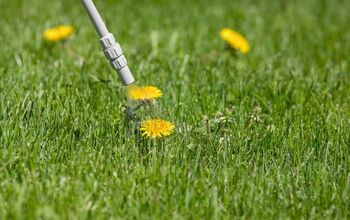What To Do With Dead Leaves After Raking Them

Dead leaves falling on the ground signifies the beginning of a change in seasons. The vibrant colors of fall turn into bare trees and are accompanied by overnight forests and cold winds. Once the leaves fall, the first step is to rake or blow them into a large pile. What comes next, however, is less clear. What exactly should you do with your dead leaves after raking them into a pile?
After you rake up dead leaves, you can shred them and turn them into mulch. Dead leaves provide nutrients for your lawn and soil. You can mix them into the soil of your fall garden, or add them to your existing compost pile. Alternatively, you can leave them in bins for natural waste collection or bring them to your local municipality’s natural compost facility.
It’s fun for kids to jump into piles of leaves — it’s a right of passage for any child growing up in an area with four seasons. But after raking and playing, something must be done with this pile of leaves. The good news is dead leaves have many uses, and in some cases can be reincorporated into the land. Below is a list of all the best ways to utilize and dispose of your dead leaves.
Eight Ways To Dispose Of Or Utilize Your Dead Leaves After Raking
1. Add Them To Your Compost Pile
One of the best ways to utilize your dead leaves after you rake them up is to add them to your compost pile before winter hits. If you have a compost pile, layers of dead leaves and soil add significant value. They help aerate the compost pile while adding lots of valuable nutrients.
Make sure you add a layer of soil over the leaves, as this will help it break down. It will also help prevent the leaves from blowing back into your yard on a windy day. Dead leaves are rich in key nutrients your soil needs, including nitrogen, phosphorus, and carbon.
2. Stuff Them Into Your Halloween And Thanksgiving Decorations
If you like decorating your home's exterior for fall holidays, including Halloween and Thanksgiving, then consider incorporating some of your leaf pile into your decorations. You can stuff a scarecrow with dead leaves, as well as other festive creatures.
There are many holiday-shaped bags (specifically pumpkins) you can fill with leaves to give them volume. If you have beautifully colored dead leaves, you can also make a wreath or a dried bouquet that you can bring inside and incorporate into your Thanksgiving decorations.
3. Chop Or Shred Them And Sprinkle On Your Grass
Another great way to utilize the nutrients in your dead leaves is to shred them into a fine mulch. After you shred them, you can disperse this fine mulch throughout your lawn and provide it with nutrients during the winter as it breaks down.
Furthermore, being so fine, it is not likely to produce mold and other bacteria, which is common when you leave piles of large leaves on your grass. Instead, your lawn should grow back healthy in the spring.
4. Use Them For Mulch In Your Flower Beds
If you can’t make a fine mulch for your lawn, you can use crumpled-up dead leaves as a mulch in your flower garden. This provides much-needed nutrition for your perennial flowers and hedges.
Furthermore, a layer of dead leaves over the soil is a great way to protect the plant’s roots from frost. It also helps keep your late-blooming fall blossoms from freezing too early, as it can keep the moist soil a bit warmer.
5. Put Them On The Side Of The Road For Pickup
If you have more leaves that you know what to do with, it might be best to put most of them out to the curb. Every municipality does leaf pickup differently. If you live somewhere with lots of deciduous trees, then your community might just load up huge piles of leaves along the side of the road.
Alternatively, you may need to place leaves in your natural waste bins. Make sure you know the proper protocol, as well as the pickup days. This will ensure your leaves get picked up promptly and don’t have time to migrate back into your yard with the wind.
6. Bag Them Up And Bring To Local Compost Facility
If you are worried about leaves blowing back into your yard or you missed your pickup date, then you have another option. Many municipalities have a local natural waste or composting facility. If your community has one, find out the best way to deliver your dead leaves, and bring them accordingly.
7. Mow Them With A Lawn Mower
If your yard doesn’t have too many leaves, you might not even need to use your rake. Before putting your lawn mower away for the year, you can mow your lawn one last time. Make sure you don’t mow your grass too short, as this can shock and kill it in the winter.
Instead, simply go over the lawn, and allow your mulching mower to chop up leaves and small twigs. It will then disperse the tiny mulch throughout your lawn for you. This is a great way to feed your lawn and save time on raking, especially if you don’t have too many dead leaves on the ground.
8. Add Them To Your Fall Vegetable Garden
If you live somewhere with a long growing season, consider mixing your dead leaves in with your soil. This is a fun trick to help your fall garden succeed. For one, the leaves add a slow and steady source of nutrients for your vegetables.
Leaves mixed with soil also provide increased aeration and great drainage, which comes in very handy as fall gets wet and chilly. It can help boost your late-season garden’s productivity while getting rid of your dead leaves at the same time.
What You Should Not Do With Dead Leaves
Leave Them On Your Lawn
It’s tempting to be lazy, but if you have a grassy lawn, it’s imperative you rake or blow your leaves off it. If you neglect this important autumn chore it can cause all sorts of problems for your lawn.
A layer of dead leaves can produce mold and fungus. Later this mold and fungus can eat away at your lawn and its roots, and even kill it. Remember that a bit of raking is a lot less effort (and money) than replacing an entire lawn.
Burn Them
Perhaps the worst way to get rid of your dead leaves is to burn them. Believe it or not, this was fairly common not too long ago (and still exists in many countries today). Not only can burning your leaves cause a house or forest fire but there are serious environmental implications.
If everyone burned their leaves, there would be a lot of toxins floating into the sky. It can also make the air quality very bad near your home.
Dispose Of Them In Plastic Bags
With so many healthy and productive ways to utilize and dispose of your leaves, it would be a tragedy to allow them to end up in a landfill. You should never bag your leaves in plastic bags and put them in the trash.
If you need to bag up your leaves, there are large paper bags you can purchase specifically for leaves and natural products. They are fully recyclable, and most recycling companies will pick them up without an issue.
Wrapping Up How To Dispose Of Your Dead Leaves After Raking
After you rake all the leaves off your lawn, you might think your job is done. In some cases, your municipality might come by and suck up your entire pile, but in other cases, you need to figure out what to do with your pile of dead leaves. Consider adding them to your compost pile, or turning them into mulch to feed your lawn and flowers. You can even mix them with garden soil and add them to your late-season vegetable garden.
Related Guides:

Tom Gaffey is an expert writer who currently resides in Washington D.C. Tom has a passion for real estate and home improvement writing, as well as travel and lifestyle writing. He lived the last twelve years in Hawaii where he worked closely with luxury resorts and event planners, mastering his knowledge of aesthetics and luxury products. This is where he found his passion for home improvement and a keen interest in DIY projects. Currently, Tom resides in Washington D.C, and also working on his debut fiction novel.
More by Tom Gaffey













![10 Best Electric Pressure Washers – [2022 Reviews & Guide]](https://cdn-fastly.upgradedhome.com/media/2023/07/31/9070600/10-best-electric-pressure-washers-2022-reviews-guide.jpg?size=350x220)













